Abstract
In this study is represented the relationship between suicidal thoughts and psychoactive abuse. In study were involved 202 students of Banjaluka’s secondary schools. By questioner for risky behaviour of adolescents (1) was found 28,7% of them have suicidal thoughts, and 144 haven’t suicidal thoughts. Students from both groups use alcohol but there are not statistically significant differences among groups. The representative sample was 202 students from Banjaluka’s secondary schools. The results showed that 28,7% of them have suicidal ideas. From examined students 20,2% used cannabis, and 4% other psychoactive substances, 56,9% alcohol and 35,6% smoke cigarettes. In the group with suicidal ideas, use of psychoactive substances is 8,6%, alcohol use in 63,7% cases and cannabis 36,2%, and smoking cigarettes in 48,2% cases. We may conclude that misuse of psy-choactive substances is more present in group with suicidal ideas, except in case of alcohol, which was also high in group with suicidal ideas, but without statistical significances. It is also possible to conclude that there is important connection between use of psychoactive substances and presence of suicidal ideas as first step toward a suicide in adolescents.
INTRODUCTION
Suicide is one of the world’s main death causes in population of adolescents in age 15 -19 years. Since 1950 the rate of suicide in population of adolescents is tripled and currently it presents third cause of death for this age group. According to the Report of WHO (2) suicide in the Europe in population of woman is fourth cause of death (9,4%), after traffic accidents, accidental injuries and tumors, and for man, third cause of death (13,6%), after traffic accidents and accidental injuries. Total percentage of committed suicides increases. Suicide, attempts of suicide and suicidal ideas, becomes broader social and medical problem. The rate of suicide vary related to age, sex, socio economical status, marital status and religion. Center for diseases control USA, in 1991, in the applied questioner for adolescents, age 14 -17, had found that 27 % of adolescents think about suicide, 16,3 % had intention to commit suicide, 8,3% had attempt of suicide and 2% had attempt of suicide which requested serious medical intervention. Each year more than 250 000 adolescents attempt suicide; 8 -10% of all children in USA try suicide in some period of childhood and 20, 5 % of students had serious thoughts about suicide (3). In spite of high prevalence, for many children, risk for suicide stays discovered; suicidal ideas which may be hint verbally, involving direct statements about intention or comment in written form, or non verbally in form of art creation or behavior. Suicidal idea or thought is defined as wish or behavior, which hints ones wish to commit suicide. Suicidal thoughts are not abnormal. It is a part of normal developmental process in adolescence, when young people analyses essential life issues and try to understand life, death and sense of life. Survey of the questionnaires shows that more than half of students of higher grades of secondary schools have suicidal ideas (2). Suicidal ideas at children and adolescents become abnormal when, realization of the ideas, seems as only way out from their problems. In such situation the risk of attempt or of suicide becomes serious. Analyses show that all described factors are more often joined to attempts and commitments of suicides between children and adolescents, but they are not necessary present in each case. As, abuse of psychoactive substances is more present in youth population. In this study we paid attention to suicidal ideas in population of adolescents. Many studies show that main reason for use of psychoactive substances is to change a mood. Alcohol, marihuana, sedatives, nicotine and caffeine decrease anxiety, suffering and relax, while, stimulants and narcotics arouse positive affects. Brent et al. had found that abuse of psychoactive substances presents risky factor to commit suicide, odds ratio 8,5 (4). Kaminer reports that many studies indicate risk for suicide at adolescents with diagnosis of substances abuse. It’s known that conduct disorders and mood disturbances are joined to suicidal behaviour and substances abuse (5). Studies of the committed suicides in population of adolescents in Scandinavia, Canada, and USA show that abuse of substances is more present in population of the victims than in the general population of adolescents. Kaminer also considers that alcohol and cocaine are especially dangerous (5). Brent et al. concluded that adolescents, especially male, who abuse psychoactive substances more often use fire arms to commit suicide, than adolescents without this disorder (6). Many of those who attempt suicide abused drugs and alcohol, with reported rates 13 -42% (7,8). Garfinkel reports that substance abuse is more often in the group of potential committer of suicide than in the control group (9). The results of this study show that five to eleven of those who attempted suicide were under influence of substances during attempt.
METHODS
This research tries to find out is there relation between suicidal ideas and use of psychoactive substances, alcohol and cigarettes, and in which proportion. The results are based on the anonym answers of 202 students of third classes of secondary schools, age 16 -18, random sample. The research is prospective, epidemio-logical. In the research questioner Q 2000 (1) was used, which involves and covers all aspects of adolescents’ life. The rate of abuse of psychoactive substances, alcohol and cigarettes and percentage of suicidal thoughts in this population were analysed. Microsoft Exel -Analyse it, program for data analyses was used.
RESULTS
CHARACTERISTICS OF THE SAMPLE The examination involved 202 students, age sixteen to eighteen years, students of third class of secondary schools, by random choice. From total number of sample, males were 51 (25,2%), and females 151 (74,8%). In age of seventeen there were 18,8%, and in age of eighteen -81, 2%. It means that the sample involves mostly adolescents in age of eighteen years. Table 1 has shown percentage of positive and negative reports about existence of suicidal ideas. 28,7 % of 202 examined reported that they have suicidal ideas, or 11 males and 47 females, what presents 58 examined in group with suicidal ideas. Table 2 shows percentage of cannabis abuse in population of adolescents with suicidal ideas and percentage between adolescents without suicidal ideas. There is statistically important difference between groups, p = 0, 0007.
TABLE 1.
Relation between suicidal ideas and sex
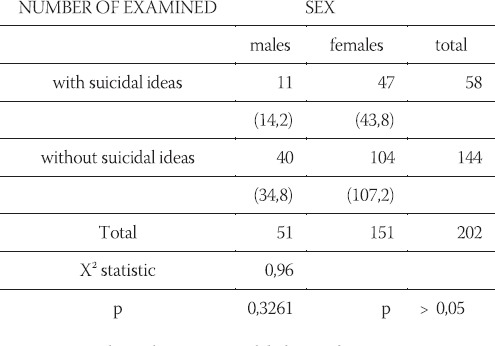
TABLE 2.
Suicidal ideas in relation to use of cannabis
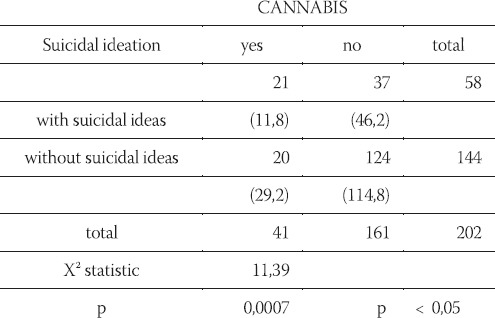
Table 3 shows the percent of use of other psychoactive substance between adolescents with suicidal ideas and without suicidal ideas. From 202 examined total numbers of those who used psychoactive substances are seven, and from that number, five have suicidal ideas. Statically important difference between groups was found, p = 0,0342
TABLE 3.
Suicidal ideas in relation to other drugs abuse
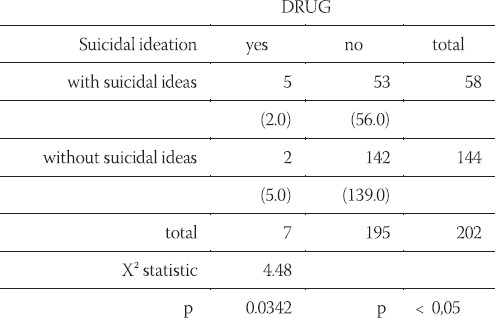
Table 4 shows that bigger number of examined from both groups consume alcohol, but without statistical significance.
TABLE 4.
Suicidal ideas in relationship to alcohol abuse
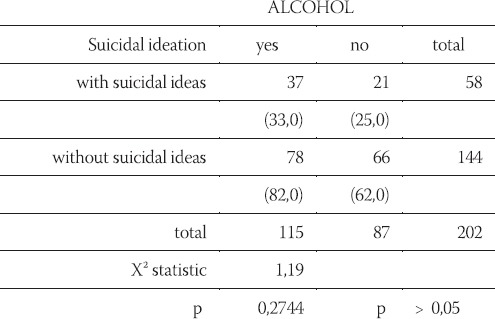
Table 5 represents presence of smoking of cigarettes in group with suicidal ideas and in group without suicidal ideas. In group of 202 examined, 72 reported that they smoke cigarettes, and 130 of them don’t have that habit. In group of smokers 28 have suicidal ideas and 44 are without suicidal ideas. Statistically significant difference between groups was found, p = 0,026.
TABLE 5.
Suicidal ideas in relation to use of tobacco
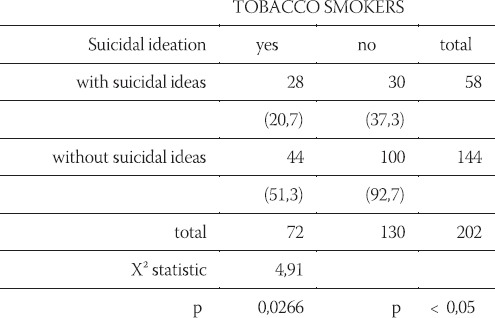
DISCUSSION
The results of this study agree with conclusions of Diekstra et al. who had found that increasing in mortality and morbidity of suicide was higher in group of white, urban adolescents in North America and Europe (10). These authors connect this to the higher number of depressive disorders and percentage of abuse of psychoactive substances. In the research was shown existence of suicidal ideas in relation to use of psychoactive substances, alcohol and smoking of cigarettes. Statistical importance was found in variable of use of psychoactive substances (except cannabis), p = 0,03 and smoking of cigarettes (p= 0, 0266), since in variable use of alcohol significance wasn’t found. Use and abuse of alcohol in population of adolescents is joined to aggressive, impulsive behaviour and disphoric mood (11). Abuse or addiction about alcohol and drugs and the other psychoactive substances in group of the adolescents is very often joined with multiple psychosocial problems, psychiatric comorbidity, suicidal ideation and suicide attempts (12) and commitment of suicide (13). In longitudinal study of adolescents who had attempt of suicide, was found, that alcohol and substances abuse are of one of biggest risk for suicide. Use of substances, with other psychopathology, social demographic distress and hard experiences during childhood are related to risk of serious suicidal behaviour in population of adolescents (14). In unselected suicidal population alcohol abuse or addiction was found between at 15 -56 % of victims same as substances abuse. Particular explanations for cigarettes use as passive way to show anger were given. Smoking of cigarettes in recent years has importantly increased. Long-term use of nicotine is related to self-medication and effort to cope with the negative emotional, neurotic and social effects of unfavourable experiences from a childhood. Problems with the depressive mood were more expressed in group of the smokers. The results of the study indicate that psychoactive substances abuse present one of risky factors for suicide in population of adolescents. Due to dates WHO (2), the abuse of psychoactive substances because changes in family relationships, school, feeling of loneliness, isolation, what generate anxiety, which may cause appearance of suicidal ideas, attempt of suicide or suicide.
CONCLUSION
According to the obtained data it has been concluded that one ofthe possible risk factors ofsuicidal thoughts in adolescents are the abuse of psychoactive substances. It must be taken into account in every program of prevention ofsuicide in adolescents.
REFERENCES
- 1.Berg-Kelly K. Normativedevelopmental behavior with implications for health and health promotion among adolescents a Swedish cross-sectional survey. Ac. Paediat. 1995;84:278–288. doi: 10.1111/j.1651-2227.1995.tb13629.x. [DOI] [PubMed] [Google Scholar]
- 2.Wassermann D. Guidelines for suicide prevention. Geneva: WHO; 2000. [Google Scholar]
- 3.US Public health servise. Washington DC: The surgeon general's call to action to prevent suicide; 1999. [Google Scholar]
- 4.Brent D.A, Perper J.A, Allman C.J. Alcohol, firearms and suicide among youth. trends in Allgheny Country, Pennsylvania, 19601983. JAMA. 1987;257:3369–3372. [PubMed] [Google Scholar]
- 5.Kaminer Y. Adolescent's substance abuse and suicidal behavior. Child. and Adolesc. Vol. 5. Psychiatric Clinics of North. Am; 1996. p. 5971. [Google Scholar]
- 6.Brent D.A, Perper J.A, Moritz G.M. Psychiatric effects of exposure to suicide among the friends and acquaintances of adolescents suicide victims. J. Am. Acad. Child. Adolesc. Psychiat. 1993;31:629–640. doi: 10.1097/00004583-199207000-00009. [DOI] [PubMed] [Google Scholar]
- 7.Hawton K, O'Grady J, Osborn M, Cole O. Adolescents who take overdose, their characteristic, problems and contact with help agencies. Br J Psychiat. 1982;140:118–123. doi: 10.1192/bjp.140.2.118. [DOI] [PubMed] [Google Scholar]
- 8.Spirito A, Brown L, Overholser J, Fritz G. Attemptedsuicide in adolescence A review and critique of the literature. Clin. Psychol, 1989;9:335–363. [Google Scholar]
- 9.Garfinkel B.D, Froese A, Hood J. Suicide attempts in children and adolescents. Am J Psychiat. 1982;139:1257–1261. doi: 10.1176/ajp.139.10.1257. [DOI] [PubMed] [Google Scholar]
- 10.Diekstra R.F. W, Kienhorst C.W. H, de Wilde E.J. Suicide and suicide behavior among adolescents. In: Rutter M, Smith D. J., editors. Psychosocial disorders in Young People. Chichester, Wiley: Time, trends and their causes; 1995. [Google Scholar]
- 11.Bukstein O.G, Brent D.A, Perper J.A, Moritz G, Bougher M, Scheers J, Rosh C, Balach L. Risk factors for completed suicide among adolescents with a lifetime history of substance abuse a case-controlled study. Acta Psychiat Scand. 1993;88:403–408. doi: 10.1111/j.1600-0447.1993.tb03481.x. [DOI] [PubMed] [Google Scholar]
- 12.Berman A.L, Jobes D.A. In: Treatment of suicidal adolescents. In Leenaers. Treatment of suicidal people. Maltslerger I.T, Neimeyer R.A, editors. Vol. 13. Washington: Taylor&Furnas; 1994. [Google Scholar]
- 13.Shaffer D, Gould M.S, Flory M, Fisher P, Troutman P, Moreom D, Kleirman M. Psychiatricdiagnoses in child and adolescent suicide. Arch. Gen. Psychiat. 1996;53:339–348. doi: 10.1001/archpsyc.1996.01830040075012. [DOI] [PubMed] [Google Scholar]
- 14.Beautrais A.L, Joyce P.R, Mulder R.T, Ferguson D.M, Deaval B.J. NightingaleS.K, Prevalence and comorbidity of mental disorders in persons making serious suicide attempts. A case controlled study. Am J Psychiat. 1996;153:1009–1014. doi: 10.1176/ajp.153.8.1009. [DOI] [PubMed] [Google Scholar]


